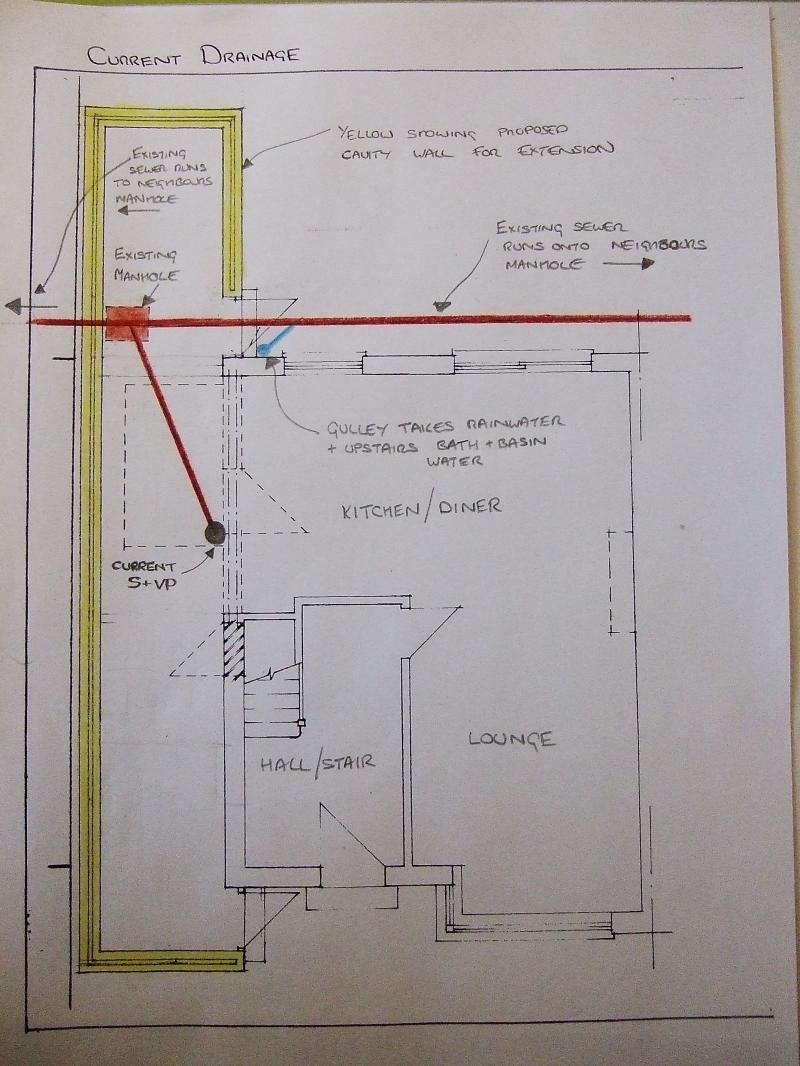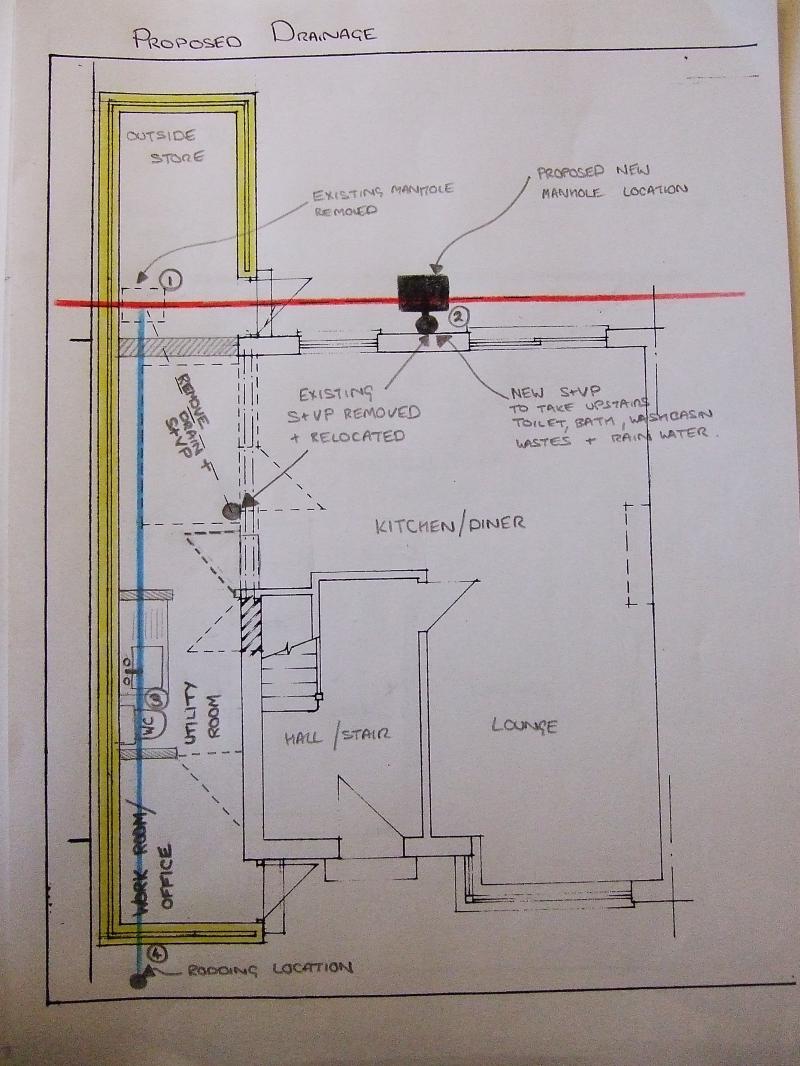Hello All,
I have been asking a couple of drainage questions over the last couple of weeks (thanks for all the useful replies and information very much appreciated). All this has been with a proposed extension in mind.
I think I am going to go ahead and its the drainage design which seems to be proving most troublesome to get my head around so I wonder if people would mind taking a look at my current drainage on the plan below and then my proposed drainage and answering a few queries I have.
Thanks in advance for any time spent and any opinions and information people can supply.
Image 1 ==>
Ok so the first image is of my current situation. Its a plan view of my semi-detached 2 storey house, front at bottom of diagram rear at top. Party wall and neighbours would be on the right of the diagram. The yellow shaded area is the cavity wall proposed for a side extension (single storey).
On this you can see the current location of the SVP (left hand side of pic). Also marked in red line is the drain from this to an existing manhole. This manhole is a line of manholes that run down the backs of the properties on the street and all connect up (direction of flow left to right on diagram - sorry forgot to put that on). Realise that the drain from the SVP runs against flow but its just the diagram and think this is overcome by shallow bends so at the manhole it sweeps in correct direction of flow.
There is also a short gulley connected into the sewer (marked in blue at the left corner of the current house). This takes rain water and waste from upstairs bath and wash basin which all empty into an open hopper half way up my rear wall (realise from other post today that open hoppers are now not considered good practice and dont comply with part H).
Image 2 ==>
Image 2 is what I am thinking I MAY be able to do to conform with current regulations etc. In this diagram you will see that I have a proposed utility with a WC and basin (marked (3)). I will also be looking to relocate my boiler to this room and therefore will need to deal with condensate from that.
At point marked (1) I intend to remove the current manhole and have a connection at this point to the new WC in the utility. Shown with the blue line.
At point (2) I want to put a new manhole and relocate my SVP close by as shown in black. I will remove the existing SVP and drain when doing ground works on the extension.
OK so now (finally) the questions! Thanks if you got this far.
1) At point marked (4), bottom left of proposed plan I have shown a rodding location. I have extended the run from the WC to the front of the extension to allow this run to be rodded as at point (1) there will no longer be access. Is this ok/necesary? or can I allow a rodding point in the utility room somehow (stub stack)? I wasn't quite sure if access was needed for my neighbours if I was away or whether this part of the drain would be considered non public.
2) Would I need any sort of ventilation on this WC drain? Stub stack and AAV (air admittance valve)?
3) At point marked (2) I intend to relocate my soil pipe. My question is... the gulley marked in Image 1 currently takes rain water and the wash basin and bath waste from upstairs as well as downstairs sink and washing machine... i.e. rain water and grey waste go into same gulley. This gulley will not be able to be left in place and so I had intended to run all the above into the new SVP. Is that OK i.e. is it ok to run the waste from sinks etc and rainwater from guttering into SVP? It does all end up at the same drain running along the backs of the houses in red at the moment.
4) In the Utility where I have shown a WC and sink I also want to put a washing machine and relocate my boiler, I was thinking that this could all discharge into the WC using a connection something like this ==> http://www.mcalpineplumbing.com/boss-pipe-for-use-with-wc-connectors.html would that be ok? i.e. the condensate wash basin and washing machine run into a 40mm branch pipe and then into that connection? I understand that the connections and pipe taking condensate from boilers need to be made of material to withstand particular pH values as per part H.
5) Final question ... promise! Any general problems in any way with what I propose from a regulations/ease of build/poor design point of view. I realise that for the point (1) that I will need to get local water company involved as it will require some sort of build over agreement, and that all this will need to be checked out by the BCO but just wanted to ask those with far more knowledge than myself up front. That way I sort of know where I am when I talk to a local builder and don't feel such a donkey!
Sorry again for such a long post and many thanks in advance for any help. As always much appreciated.
Bonce
I have been asking a couple of drainage questions over the last couple of weeks (thanks for all the useful replies and information very much appreciated). All this has been with a proposed extension in mind.
I think I am going to go ahead and its the drainage design which seems to be proving most troublesome to get my head around so I wonder if people would mind taking a look at my current drainage on the plan below and then my proposed drainage and answering a few queries I have.
Thanks in advance for any time spent and any opinions and information people can supply.
Image 1 ==>
Ok so the first image is of my current situation. Its a plan view of my semi-detached 2 storey house, front at bottom of diagram rear at top. Party wall and neighbours would be on the right of the diagram. The yellow shaded area is the cavity wall proposed for a side extension (single storey).
On this you can see the current location of the SVP (left hand side of pic). Also marked in red line is the drain from this to an existing manhole. This manhole is a line of manholes that run down the backs of the properties on the street and all connect up (direction of flow left to right on diagram - sorry forgot to put that on). Realise that the drain from the SVP runs against flow but its just the diagram and think this is overcome by shallow bends so at the manhole it sweeps in correct direction of flow.
There is also a short gulley connected into the sewer (marked in blue at the left corner of the current house). This takes rain water and waste from upstairs bath and wash basin which all empty into an open hopper half way up my rear wall (realise from other post today that open hoppers are now not considered good practice and dont comply with part H).
Image 2 ==>
Image 2 is what I am thinking I MAY be able to do to conform with current regulations etc. In this diagram you will see that I have a proposed utility with a WC and basin (marked (3)). I will also be looking to relocate my boiler to this room and therefore will need to deal with condensate from that.
At point marked (1) I intend to remove the current manhole and have a connection at this point to the new WC in the utility. Shown with the blue line.
At point (2) I want to put a new manhole and relocate my SVP close by as shown in black. I will remove the existing SVP and drain when doing ground works on the extension.
OK so now (finally) the questions! Thanks if you got this far.
1) At point marked (4), bottom left of proposed plan I have shown a rodding location. I have extended the run from the WC to the front of the extension to allow this run to be rodded as at point (1) there will no longer be access. Is this ok/necesary? or can I allow a rodding point in the utility room somehow (stub stack)? I wasn't quite sure if access was needed for my neighbours if I was away or whether this part of the drain would be considered non public.
2) Would I need any sort of ventilation on this WC drain? Stub stack and AAV (air admittance valve)?
3) At point marked (2) I intend to relocate my soil pipe. My question is... the gulley marked in Image 1 currently takes rain water and the wash basin and bath waste from upstairs as well as downstairs sink and washing machine... i.e. rain water and grey waste go into same gulley. This gulley will not be able to be left in place and so I had intended to run all the above into the new SVP. Is that OK i.e. is it ok to run the waste from sinks etc and rainwater from guttering into SVP? It does all end up at the same drain running along the backs of the houses in red at the moment.
4) In the Utility where I have shown a WC and sink I also want to put a washing machine and relocate my boiler, I was thinking that this could all discharge into the WC using a connection something like this ==> http://www.mcalpineplumbing.com/boss-pipe-for-use-with-wc-connectors.html would that be ok? i.e. the condensate wash basin and washing machine run into a 40mm branch pipe and then into that connection? I understand that the connections and pipe taking condensate from boilers need to be made of material to withstand particular pH values as per part H.
5) Final question ... promise! Any general problems in any way with what I propose from a regulations/ease of build/poor design point of view. I realise that for the point (1) that I will need to get local water company involved as it will require some sort of build over agreement, and that all this will need to be checked out by the BCO but just wanted to ask those with far more knowledge than myself up front. That way I sort of know where I am when I talk to a local builder and don't feel such a donkey!
Sorry again for such a long post and many thanks in advance for any help. As always much appreciated.
Bonce



